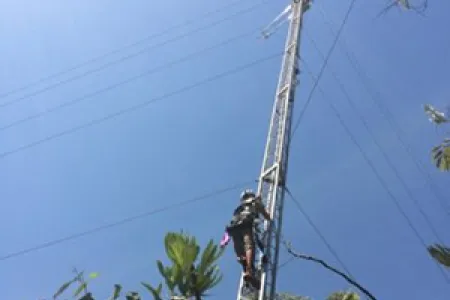Litchfield SuperSite to track ecosystem health
Australia’s first tropical savanna “SuperSite” has been created in the heart of Litchfield National Park to provide crucial data for understanding the global carbon cycle.
Scientists will explore responses to environmental change in the tropical savanna, the dominant ecosystem of Northern Australia, including how fire impacts on carbon storage, energy exchange with the atmosphere and biodiversity.
At the $200,000 Litchfield Savanna SuperSite, a 40-metre cyclone-proof tower anchored by 100 tonnes of concrete supports instruments measuring carbon, water vapour and energy exchanges in the ecosystem.
The Litchfield SuperSite is the latest site to join the Australian SuperSite Network as part of the Federal Government-funded Terrestrial Ecosystem Research Network (TERN), in which Charles Darwin University is a partner.
As Litchfield site leader, CDU environmental science Professor Lindsay Hutley said studies conducted at the site would provide critical information on the global uptake of carbon.
“Savannas are the second largest tropical ecosystem in the world, representing 12 per cent of the Earth’s land surface and 30 per cent of Australia,” he said.
“The SuperSite will be a one-stop-shop of ecosystem monitoring and we hope to conduct a wide range of environmental and remote sensing studies over time.”
CDU researchers will conduct long-term monitoring of fire events, changes in vegetation structure and canopy cover, bird and invertebrate biodiversity and soil moisture at the SuperSite.
“The potential for enhancing carbon storage in these ecosystems via changes to savanna burning regimes can be explicitly tested here,” Professor Hutley said.
On-ground measurements of vegetation and fire at the SuperSite will also be compared to information collected from remote sensing satellites (NASA, ESA), through TERN’s remote sensing facility, AusCover.
Director of CDU’s Research Institute for the Environment and Livelihoods and Chair of TERN, Professor Andrew Campbell said the SuperSite was a critical piece of national research infrastructure.
“Understanding the carbon and water cycles in ecosystems of Northern Australia is crucial for the Northern development agenda, and for feeding into global climate models,” Professor Campbell said.
CDU undergraduate students will take part in field trips and postgraduate students will conduct research projects at the SuperSite. The tower at the SuperSite is part of TERN’s OzFlux Facility.
Agencies involved in the Litchfield Savanna SuperSite include the Darwin Centre for Bushfire Research at CDU, Bushfires NT, NT Parks and Wildlife, NT Department of Land Resource Management, the University of Western Australia (UWA) and CSIRO.
